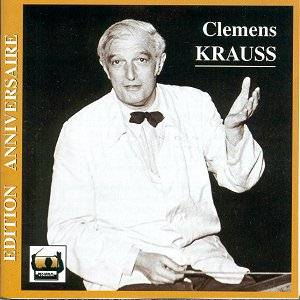One of the most famous recorded performances of Brahms’s
First – and justifiably so – was given by Wilhelm Furtwångler
a little under a year previously to this, with Hamburg’s North German
Radio Symphony Orchestra, not so far away in distance either. Legend
has it that the conductor arrived by plane in the morning, conducted
the concert in the evening – and that was it. If the legend is true,
the tightness of the performance is as miraculous as its intensity.
Something similar seems to have happened in Bremen a year later, only
with less Olympian results. An orchestra that in the first movement
of the Jupiter appear never to have seen Krauss before transform
literally movement by movement into a musical organism breathing and
playing as one to exhilarating effect.
Tahra’s policy in this anniversary edition of releasing
complete concerts is in fact vindicated here, as we have a precious
opportunity to hear and understand how musicians outside the recording
studio are humans and not instruments with muscles attached: the messy
opening chord of the Jupiter is as essential a part of that experience
as the thumping power of the coda to the Brahms. It would have been
all the more complete if the tapes had included applause, but that is
denied us.
Basic unsteadiness sabotages the whole first movement
of the Jupiter – sometimes to comic effect, as at Figure B when
Krauss picks up the tempo to the point where string articulation is
apparently impossible: all is busyness and noise. Flow already starts
to succeed haste in the slow movement, graced by some gorgeously sung
lines from the clarinet and cellos, but the last bars, taken completely
in tempo, lose that poise. At a more sensible speed the Minuet and Trio
(with all repeats; the other movements have none) gain wit and charm,
especially the end of the trio with its unfinished phrase, which Krauss
makes hang in the air like a throwaway question. More scrappy playing
and timpani that sound as though they have been borrowed from a school
barely cloud my enjoyment of the finale’s high spirits and Krauss’s
clear delineation of the fugal lines. Grandeur is sacrificed with the
repeats, but Krauss’s approach makes a change from the portentous ‘summation
of Mozart’s symphonic oeuvre’ heard in versions by Karajan, Bernstein
and Barenboim.
Those wayward timpani are already more focused for
the tattoo which opens Brahms’s First, and on their foundation Krauss
builds a sombre introduction, from which the fast and flexible allegro
springs as all the more of a surprise. He disdains sharp accents, and
the orchestra don’t attempt them at this tempo, but the argument of
the music is all there, instantiating Krauss’s aim, stated in the booklet,
‘to give shape to the music beyond the actual notes’. No phrase, no
line in this performance lacks shape, at whatever tempo, and because
of this shape he and the musicians get away – to my ears – with all
manner of sloppiness. The orchestra’s sound does not well from the bass
as in many classic Brahms performances; the moment-to-moment tension
perhaps precludes that.
The first tempo for the finale’s main theme is absurdly
fast, so much so that you wonder how he can ever gain extra animato
when Brahms asks for it: but the tempo accelerates before the marking
and by the time it comes the musicians are swept away on a rushing torrent
(with the exception of the horns, who are less than certain!). The return
of the theme is more sturdy, but there is little sense of two basic
tempi which are usually the bedrock of this movement, adhered to more
(by Wand) or less (by Furtwängler) strictly. The excitement level
is already so high that some may weary at the unceasingly frenetic feel.
Even the restatement of the chorale theme in the coda rejects nobility
for brassy boldness. Krauss finds in the piece an impetuosity and even
violence that is one unignorable side of Brahms’s musical personality,
and this disc is well worth hearing if only to appreciate that.
Peter Quantrill


